Achieve Energy Savings in Plant Facilities
John M. Gross, Plant Engineering and Maintenance (PEM) Magazine
Whether it’s turning off lights, idling back process equipment and fixing compressed air leaks to energy audits and installing compressed air management systems, reducing utility costs to achieve energy savings in plant facilities can take several forms. As with any project, the return on investment should guide you on the projects that you select.
Let’s start with lighting and air leaks. While turning off lights and idling process equipment may generate a huge savings, it sends a message about conservation and preventing waste. The key is to not create any safety hazards and have a plan for start-up. Larger savings can be found with air leaks.
From my experience, air leaks happen over time and are often unnoticed or ignored. Air leaks can be detected the old fashioned way by listening for the leaks when the plant is shut down, or you can use an ultrasonic detector. The ultrasonic detector detects sound waves and can also be used for predictive maintenance.
Moving up the cost curve, you should consider an energy audit. The energy audit will identify ways to save energy and can sometimes spot tax or utility bill savings. Like most audits, you will receive some practical suggestions along with some off-the-wall ideas. Evaluate the report and use your judgment on what to implement. Remember, you’re trying to reduce energy costs—not win a high school science fair.
One suggestion that always raises questions from senior management involves the installation of new full spectrum, high-bay fixtures and bulbs. The questions stem from the fact that these fixtures look like the old fluorescent fixtures, which we replaced with metal-halide fixtures years ago. These lights, however, really work. Lighting levels will go up and you save money. Another consideration is how large is the power factor in your plant? Are you being charged for it by the local utility?
Don’t forget the power factor is the measure of reactive power, which results in increased current flow between the power source and the load. The power company charges the power-factor correction surcharge to cover the undocumented additional power. Reactive power is typically caused by the inductance from electric motors and can be corrected by adding capacitors to the electrical system. The cost for the capacitors is based on their size, which will depend on where they’re placed in the circuit.
Because of the decisions and resultant cost, think carefully and don’t be afraid to seek additional advice before making an investment.
Typically, power-factor correction usually works best when applied to larger motors. To justify the cost, make sure that you understand electricity savings before making any purchases. My last suggestion deals with compressed-air management systems. These systems save money by storing compressed air at higher pressure than your plant system, while allowing compressors to idle. As a result, you save money.
These cost-effective systems can smooth out your plant’s air pressure. It can get expensive, however, if you have older compressors and don’t have a large air-storage system. Years ago, I lucked out when installing one of these systems. I found three 5,000-gallon tanks sitting in our sister plant’s “bone yard.”
The key to making these systems economically viable is being able to store the compressed air at a 10 to 15-psi higher pressure than the plant system. If you can store the compressed air at 25-psi difference, then you will see some real savings. As expected, companies selling the system will be more than happy to help you calculate the savings. They will also know if you qualify for any helpful energy savings funding that’s available from utility companies or the government. Regardless of the economic situation, maintainers should always be looking for ways to reduce cost. When you’re considering and selecting energy savings options—do your homework. Quantify your savings and have a realistic installation and start-up plan.
Click here to learn more about Energy Optimization in your Plant Facility.
John M. Gross works as a Six Sigma master Black belt and lean manufacturing manager for a Tier 1 automotive supplier. He’s the author of Fundamentals of Preventive Maintenance and coauthor of Kanban Made Simple. John is a professional engineer as well as a certified plant and quality engineer. You can reach him by email: [email protected].
Related Articles

Eliminating Conveyor Concerns

The Full Circle of Engineering Education

Developing Marketable Engineering Skills

Preheater Points Out the Value of Cooling Off

Design for Maintainability: The Innovation Process in Long Term Engineering Projects




